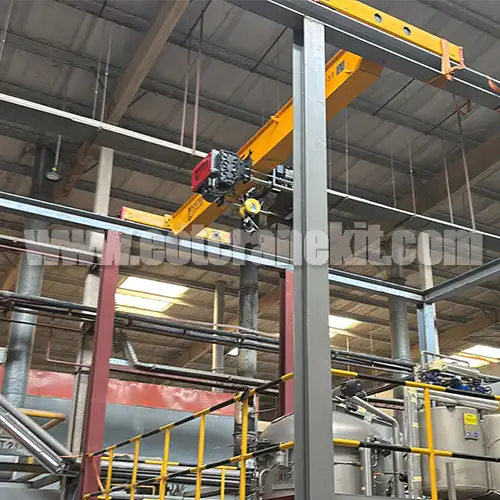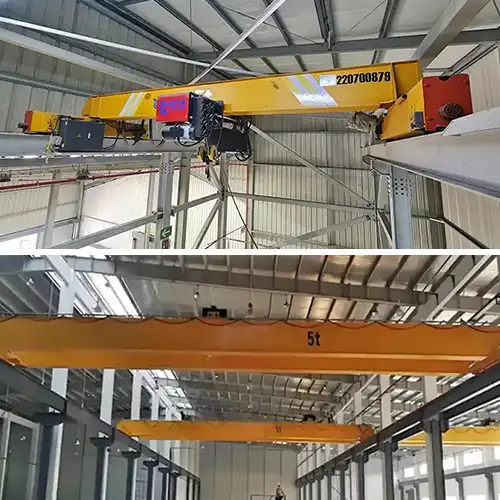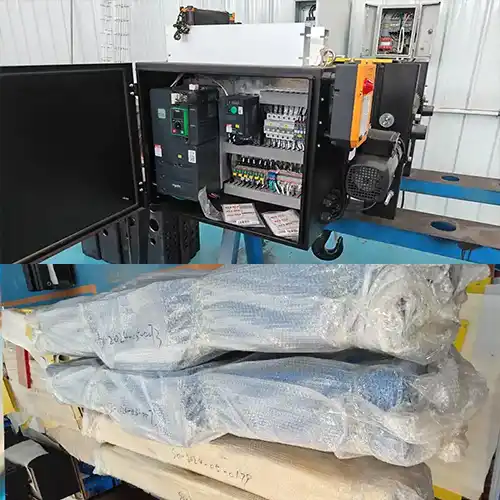5 Ton Overhead Cranes Types,Parts & How They Affect Crane Price
5 ton overhead crane for sale. Check overhead crane types, parts and components & How they affect 5 ton overhead crane price. Get your 5 ton crane design!
Category: 5 Ton Overhead Crane
Your Trusted 5 Ton Overhead Crane Manufacturer & Supplier
5 Ton Overhead Cranes Types,Parts & How They Affect Crane Price
5 ton overhead crane for sale. Check overhead crane types, parts and components & How they affect 5 ton overhead crane price. Get your 5 ton crane design!
When it comes to optimizing material handling in industries, few tools match the versatility and reliability of 5 ton overhead cranes. These robust machines effortlessly lift and transport heavy loads, streamlining operations and enhancing productivity across various sectors. But before delving into the world of overhead cranes, it's crucial to grasp the significance of understanding pricing and its associated factors.
That's precisely what a 5 ton overhead crane offers. These powerful machines consist of a bridge, hoist trolley, and end trucks, working in unison to tackle demanding lifting tasks with efficiency. Whether in manufacturing facilities, warehouses, or construction sites, 5 ton overhead cranes play a pivotal role in optimizing material handling operations.
In making business decisions, knowledge is power. Understanding the intricacies of pricing considerations surrounding 5 ton overhead cranes is paramount for making informed choices and maximizing returns on investment. From factors influencing price to budget-friendly options versus premium models, comprehending pricing dynamics empowers decision-makers to align investments with operational needs and financial goals.
5 Ton Overhead Crane Design and Specifications
The design and specifications of a 5 ton overhead crane play a pivotal role in determining its performance, durability, and ultimately, its price.
Main Type of 5 Ton Single Girder Overhead Crane:
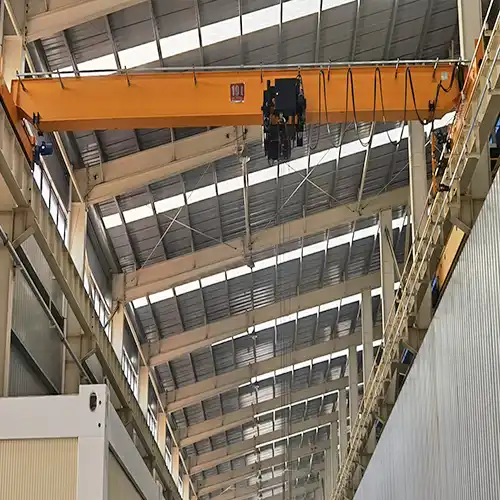
Top Running Single Girder Overhead Crane:
Features: This crane configuration has a single girder mounted on top of runway beams.
Benefits: Offers excellent hook approach, greater lifting heights, and heavy-duty lifting capacities.
Applications: Ideal for facilities requiring efficient material handling of heavy loads with significant lifting heights, such as manufacturing plants, warehouses, and steel mills.
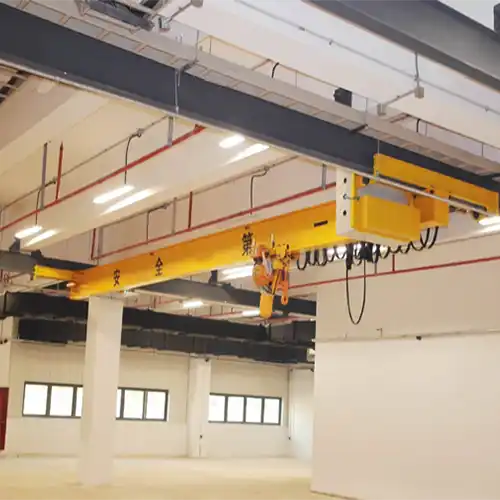
Under Running Single Girder Overhead Crane:
Features: Utilizes a single girder mounted underneath the runway beams.
Benefits: Suitable for operations with limited headroom or confined overhead space.
Applications: Commonly used in workshops, assembly lines, and facilities with low ceilings or obstacles where overhead clearance is restricted.
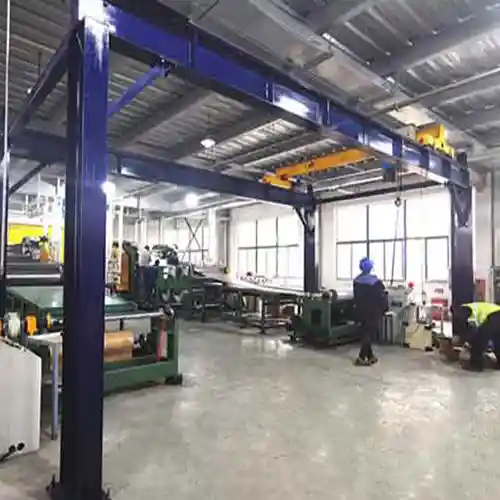
Free Standing Single Girder Overhead Crane:
Features: This crane type has a self-supporting structure with columns supporting the crane runway.
Benefits: Offers versatility in placement and layout design, suitable for outdoor applications or facilities with large open spaces.
Applications: Used in outdoor storage yards, construction sites, and facilities where traditional building-mounted cranes are impractical or unavailable.

Low Headroom Single Girder Overhead Crane:
Features: Specifically designed with a low-profile configuration to maximize vertical space utilization.
Benefits: Ideal for facilities with limited overhead clearance or tight spaces.
Applications: Commonly used in workshops, warehouses, and production lines where overhead space is constrained but efficient material handling is required.

Explosion Proof Single Girder Overhead Crane:
Features: Engineered with specialized components and construction materials to prevent the risk of ignition in hazardous environments.
Benefits: Ensures safe operation in potentially explosive atmospheres, such as oil refineries, chemical plants, and pharmaceutical facilities.
Applications: Used in environments where flammable gases, vapors, or dust particles are present, requiring compliance with stringent safety regulations.

Cleanroom Single Girder Overhead Crane:
Features: Designed with sealed components and minimal exposed surfaces to prevent contamination in cleanroom environments.
Benefits: Ensures cleanliness and sterility in critical manufacturing processes, such as semiconductor fabrication, pharmaceutical production, and food processing.
Applications: Used in cleanroom facilities where maintaining a controlled environment is essential for product quality and safety.

Hot Ladle Handling Overhead Crane:
Features: Engineered with specialized heat-resistant materials and components for handling molten metal ladles.
Benefits: Withstands extreme temperatures and harsh conditions associated with molten metal handling operations.
Applications: Commonly used in steel mills, foundries, and metallurgical plants for transferring hot molten metal ladles between processing units.

Magnetic Single Girder Overhead Crane:
Features: Equipped with magnetic lifting devices for handling ferrous materials such as steel plates, coils, and scrap metal.
Benefits: Provides efficient and precise material handling without the need for slings or hooks, minimizing load damage and improving productivity.
Applications: Used in metal fabrication shops, recycling facilities, and steel processing plants for lifting and transporting ferrous materials.

Grab Bucket Single Girder Overhead Crane:
Features: Equipped with a grab bucket attachment for handling bulk materials such as sand, gravel, and coal.
Benefits: Offers efficient loading and unloading of loose or granular materials, reducing manual labor and improving throughput.
Applications: Commonly used in ports, mining operations, and bulk material handling facilities for loading and unloading ships, barges, and trucks.
Types of Double Girder Overhead Cranes
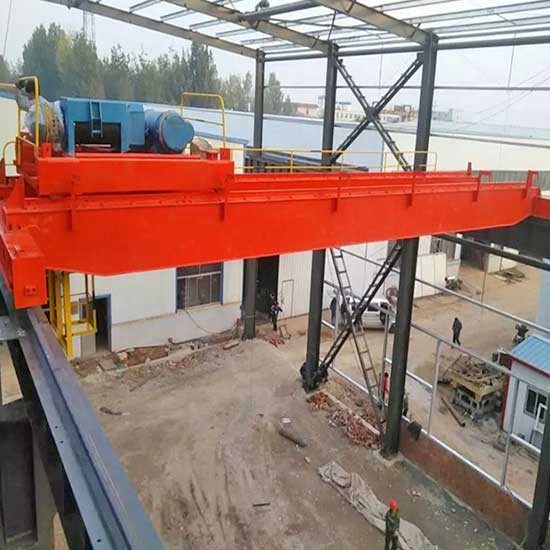
Chinese style double girder hook crane with hoist trolley
- Lifting capacityof double girder hook crane: 5 - 63 ton
- Span lengthof double girder hook crane: 7.5 to 31.5m
- Customized service
The most common medium-sized material handling equipment, suitable for most factories, warehouses, and other facilities. Suitable for users who use their computers on a regular basis.
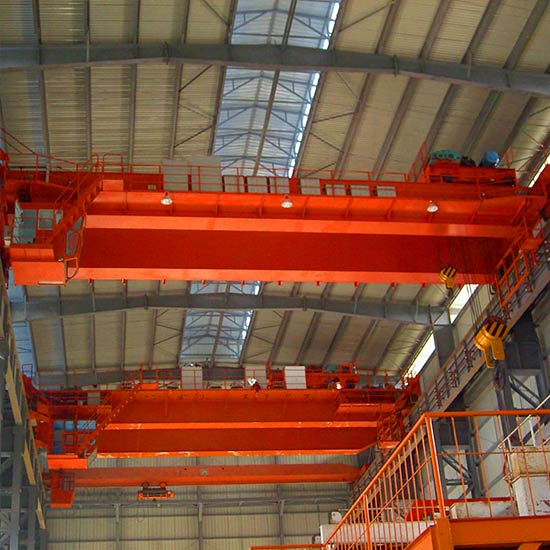
Chinese style double girder hook crane with open winch trolley
- Lifting capacityof double girder hook crane: 5 - 550 ton
- Span lengthof double girder hook crane: 7.5 to 31.5m
- Customized service
Overhead electric winch crane is China traditional heavy duty double girder overhead crane equipped winch trolley,Robust & Sturdy, Affordable industrial overhead winch cranes.
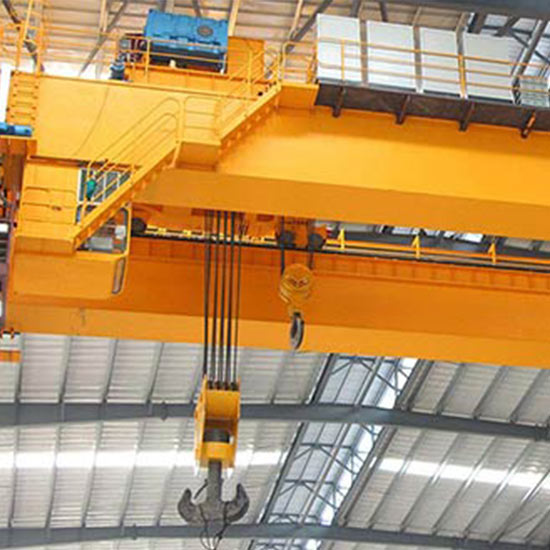
European style double girder hook crane with open winch
- Lifting capacityof double girder hook crane: 5 - 550 ton
- Span lengthof double girder hook crane: 7.5 to 31.5m
European standard double girder overhead crane with open winch trolley, a heavy duty winch crane up to 320 ton, wide specifications hook cranes for wide application. Get FEM / DIN open winch travelling bridge crane now!
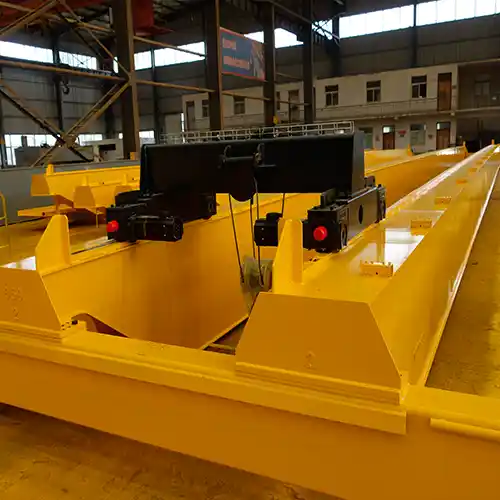
European style double girder hook crane with hoist trolley
- Lifting capacityof double girder hook crane: 5 -80 ton
- Span lengthof double girder hook crane: 6 to 31.5m
Advanced double girder overhead crane based on European DIN/FEM Standard with 5 ton-80 ton electric wire rope hoist trolley for hoisting industrial materials - European advanced wire rope hoist cranes!
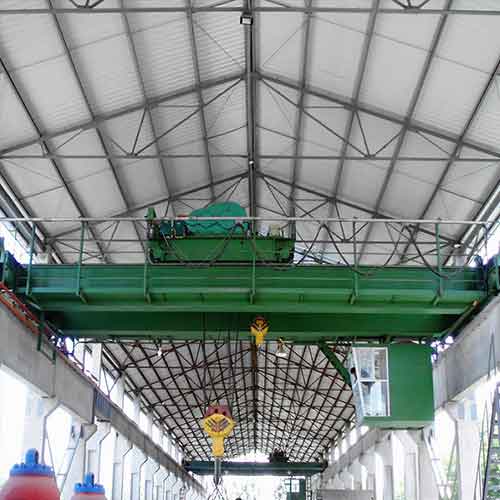
Double Girder Explosion Proof Overhead Crane
- Lifting capacityof double girder hook crane: 3 -50 ton
- Span lengthof double girder hook crane: 6 to 31.5m
Double girder explosion proof overhead cranes are designed for hazardouse environments to ensure safety in workshop with explosive gas or dusty substance . Check to get your custom double girder overhead crane.
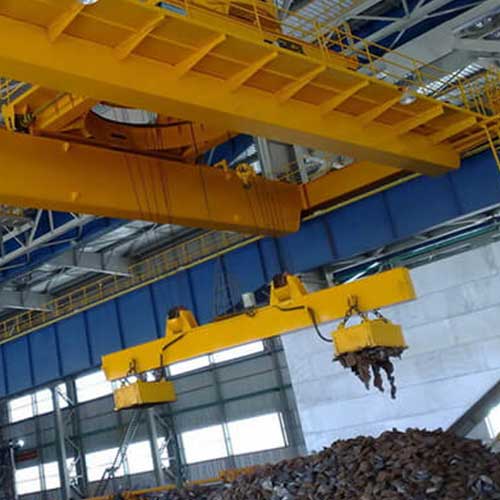
Double Girder Mangetic Overhead Cranes
- Lifting capacityof double girder hook crane: 1 -30 ton
- Span lengthof double girder hook crane: 6 to 31.5m
Magnetic overhead crane for different metal loads handling such steel scraps, steel coils, steel plate, steel rebars, steel profile, and other steel productions to improve efficient. Custom magentic overhead cranes for your needs.
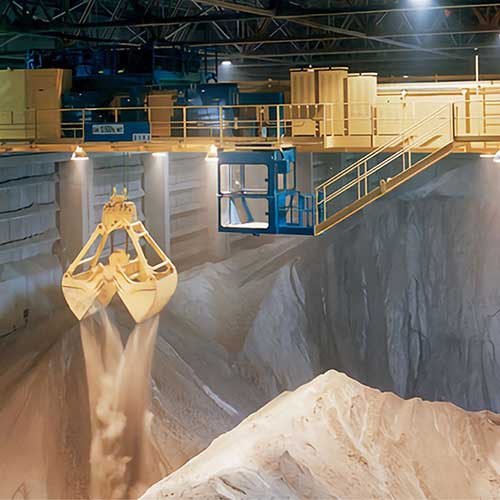
Double Girder Grab Bucket Overhead Cranes
- Lifting capacityof double girder hook crane: 1 -20 ton
- Span lengthof double girder hook crane: 6 to 31.5m
Advanced double girder overhead crane based on European DIN/FEM Standard with grab bucket for bulk material handling. Bulk material handling for various industrial use. Get your grab overhead crane design now.
Let's explore the various aspects of crane design and specifications and their influence on pricing:
Overview of Overhead Crane Components and Their Impact on Pricing
To truly understand the pricing of a 5 ton overhead crane, it's essential to dissect its components and their respective contributions to the overall cost. Components such as bridge girders, hoist trolleys, end trucks, and electrical components each have unique design specifications that directly influence the crane's performance and price. By examining these components in detail, businesses can gain valuable insights into how design choices impact pricing and functionality.
The main parts and components of a 5 ton overhead crane typically include:
- Bridge Girder: The bridge girder forms the overhead structure of the crane and supports the hoist and trolley. It spans the width of the working area and moves along the crane runway.
- Hoist: The hoist is the lifting mechanism of the crane, responsible for raising and lowering loads. It consists of a motor, gearbox, drum, and wire rope or chain.
- Trolley: The trolley is a wheeled mechanism that moves horizontally along the bridge girder, allowing the hoist to position loads accurately across the working area.
- End Trucks: End trucks are located at either end of the bridge girder and support its weight while allowing it to move along the crane runway. They typically contain wheels, motors, and drive mechanisms.
- Electrical Components: These include motors, controls, wiring, and safety devices that power the crane's operation and ensure safety compliance.
- Safety Features: Safety features such as overload protection, emergency stop buttons, limit switches, and collision avoidance systems are essential for protecting personnel and equipment.
The selection of these parts and components can significantly affect the price of a 5 ton overhead crane:
- Quality: High-quality parts and components from reputable manufacturers may come at a higher price but offer superior performance, reliability, and longevity. Conversely, opting for lower-quality components may result in lower upfront costs but could lead to increased maintenance and downtime expenses in the long run.
- Capacity and Specifications: Choosing components with higher lifting capacities or advanced features, such as variable speed controls or automated systems, will typically increase the overall price of the crane.
- Customization: Tailoring the crane's specifications to specific operational requirements, such as specialized attachments or control systems, may result in additional costs but can optimize efficiency and productivity.
- Safety Features: Incorporating advanced safety features and compliance measures may add to the upfront cost of the crane but can mitigate the risk of accidents, injuries, and downtime, ultimately adding value to the investment.
By carefully selecting the parts and components of a 5 ton overhead crane based on performance, reliability, and safety considerations, businesses can optimize their investment and maximize the crane's efficiency and longevity.
Design considerations and their influence on pricing
Structural integrity, material selection, and ergonomic design are critical considerations in the design of a 5 ton overhead crane. A well-designed crane not only performs optimally but also offers longevity and reliability, minimizing maintenance costs in the long run. However, these design considerations come at a price, as superior materials, advanced engineering, and ergonomic features contribute to the overall cost of the crane. By understanding the trade-offs between design choices and pricing, businesses can make informed decisions that balance performance with budget considerations.
Design considerations play a crucial role in determining the performance, reliability, and longevity of a 5 ton overhead crane. Here's how various design factors influence the pricing of the crane:
- Structural Integrity: The structural integrity of the crane ensures its stability and load-bearing capacity. High-quality materials and robust construction techniques are necessary to withstand heavy loads and harsh operating conditions. While investing in superior structural integrity may increase upfront costs, it reduces the risk of structural failures and maintenance expenses over the crane's lifespan.
- Material Selection: The choice of materials used in the construction of the crane directly impacts its durability, weight, and resistance to corrosion and wear. Opting for high-strength steel or aluminum alloys may result in higher material costs but offers enhanced performance and longevity, reducing the need for frequent repairs or replacements.
- Ergonomic Design: Ergonomic design features improve the usability and operator comfort of the crane, enhancing productivity and safety. Features such as adjustable controls, ergonomic seating, and intuitive interfaces reduce operator fatigue and minimize the risk of injuries. While incorporating ergonomic design elements may incur additional design and manufacturing costs, they contribute to a safer and more efficient work environment, ultimately increasing the crane's value.
- Advanced Engineering: Advanced engineering techniques, such as finite element analysis (FEA) and computer-aided design (CAD), optimize the crane's performance and reliability. These technologies allow for precise modeling and simulation of crane components, identifying potential weaknesses or inefficiencies before manufacturing begins. While investing in advanced engineering may add to upfront design and development costs, it ensures that the crane meets or exceeds performance expectations, reducing the likelihood of costly design flaws or failures during operation.
- Trade-offs Between Design Choices and Pricing: Designing a 5 ton overhead crane involves evaluating various trade-offs between performance, durability, and cost. While prioritizing high-quality materials and advanced engineering may result in a higher initial investment, it pays off in terms of long-term reliability and reduced maintenance costs. Conversely, compromising on design considerations to lower upfront costs may lead to inferior performance, increased downtime, and higher overall expenses over the crane's lifespan.
Design considerations directly influence the price of an overhead crane due to their impact on various aspects of crane construction, performance, and maintenance. Here's how design considerations affect the overhead crane price:
- Structural Integrity: Opting for stronger materials and robust construction techniques to ensure structural integrity increases the upfront cost of the crane. However, this investment reduces the risk of structural failures and the need for costly repairs or replacements, ultimately contributing to the crane's long-term reliability and safety.
- Material Selection: Choosing high-quality materials, such as high-strength steel or aluminum alloys, may result in higher material costs but enhances the crane's durability and resistance to corrosion and wear. While this increases the initial price of the crane, it reduces maintenance expenses over its lifespan, making it a cost-effective investment in the long run.
- Ergonomic Design: Incorporating ergonomic design features, such as adjustable controls and operator-friendly interfaces, improves usability and operator comfort. While these features may add to the design and manufacturing costs of the crane, they enhance productivity and reduce the risk of operator fatigue and injuries, resulting in long-term cost savings and improved workplace efficiency.
- Advanced Engineering: Investing in advanced engineering techniques, such as finite element analysis (FEA) and computer-aided design (CAD), optimizes the crane's performance and reliability. While these technologies may increase design and development costs, they ensure that the crane meets or exceeds performance standards, reducing the likelihood of design flaws or failures during operation.
- Customization Options: Tailoring the crane to specific operational needs through customization options, such as specialized attachments and automation features, affects the overhead crane price. While customization adds value and functionality to the crane, it typically incurs additional costs due to the engineering, manufacturing, and integration of customized components.
- Brand Reputation and Quality: Choosing a reputable manufacturer known for high-quality products often results in a higher initial investment. However, reputable brands offer reliability, performance, and after-sales support, reducing the risk of unexpected expenses and downtime associated with inferior crane products.
In summary, design considerations significantly impact the overhead crane price by influencing construction materials, manufacturing processes, and added functionalities. While prioritizing quality and performance may increase upfront costs, it ultimately leads to a more reliable, efficient, and cost-effective crane solution over its operational lifespan.
Customization options and their impact on pricing
Customization options allow businesses to tailor a 5 ton overhead crane to their specific operational needs and preferences. Whether it's specialized lifting attachments, advanced control systems, or aesthetic enhancements, customization options can add significant value to the crane but also increase its price. Businesses must carefully evaluate the cost-benefit ratio of customization options to ensure that the added functionalities justify the additional investment. By exploring customization options and their impact on pricing, businesses can identify opportunities to enhance crane performance while staying within budget constraints.
Customization options play a crucial role in tailoring 5 ton overhead cranes to meet the unique operational requirements and preferences of businesses. Here's a closer look at customization options and their impact on overhead crane pricing:
- Specialized Lifting Attachments: Customized lifting attachments, such as hooks, magnets, or specialized fixtures, are designed to handle specific loads or materials with precision and efficiency. While these attachments enhance the crane's versatility and productivity, they often require additional engineering and manufacturing efforts, leading to higher upfront costs.
- Advanced Control Systems: Upgrading to advanced control systems, such as radio remote controls or programmable logic controllers (PLCs), enables precise control and automation of crane movements. These advanced features improve operational efficiency and safety but may result in higher procurement and installation costs due to the integration of complex electronic components and software.
- Aesthetic Enhancements: Customizing the aesthetics of the overhead crane, such as paint color or branding decals, allows businesses to align the crane with corporate branding or aesthetic preferences. While aesthetic enhancements do not directly impact crane performance, they contribute to the overall visual appeal of the crane and may involve additional costs for customization and finishing touches.
- Automation Features: Incorporating automation features, such as automated load positioning or collision avoidance systems, streamlines crane operations and reduces the need for manual intervention. However, implementing automation features requires sophisticated sensors, controllers, and software integration, resulting in higher upfront investment costs.
- Specialized Safety Features: Customized safety features, such as anti-collision systems or overload protection devices, enhance workplace safety and regulatory compliance. While these safety features are essential for protecting personnel and equipment, they may add to the overall cost of the crane due to the inclusion of specialized safety components and integration efforts.
- Performance Enhancements: Customization options aimed at improving crane performance, such as higher lifting speeds or extended reach capabilities, require engineering modifications and component upgrades. While these performance enhancements optimize crane efficiency, they may incur additional costs for design, testing, and validation.
Businesses must carefully evaluate the cost-benefit ratio of customization options to ensure that the added functionalities align with their operational needs and budget constraints. While customization adds value and versatility to overhead cranes, it's essential to strike a balance between performance improvements and cost considerations to achieve an optimal solution. By working closely with crane manufacturers and suppliers, businesses can identify suitable customization options that enhance crane performance while maximizing cost-effectiveness.
5 Ton Overhead Crane Price
The price dynamics of 5 ton overhead cranes is crucial for making informed investment decisions. Let's dive into the various pricing ranges and considerations:
Factors influencing price
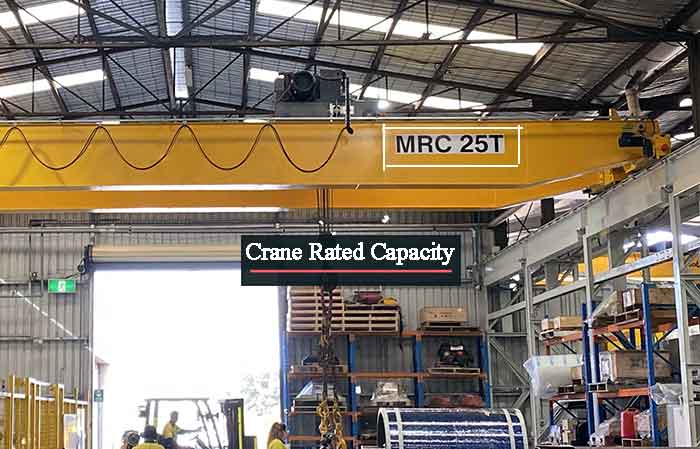
Lifting capacity:
Lifting capacity refers to the maximum weight that an overhead crane can safely lift and transport. It is a critical specification that determines the crane's suitability for various lifting tasks and the types of loads it can handle. Lifting capacity is typically expressed in tons or kilograms and is one of the primary factors considered when designing and selecting an overhead crane.
Customizing the lifting capacity of an overhead crane involves tailoring the crane's capabilities to meet specific operational requirements and load-handling needs. Here's how to customize the lifting capacity for your needs:
- Assess Load Requirements: Evaluate the types of loads that the overhead crane will need to lift and transport in your facility. Consider factors such as weight, size, shape, and center of gravity of the loads to determine the required lifting capacity. It's essential to account for both typical loads and any potential future changes or expansions in your operations.
- Calculate Load Weight: Calculate the total weight of the heaviest loads that the overhead crane will need to handle. This includes the weight of the load itself as well as any additional attachments, rigging, or accessories used during lifting operations. Ensure that the calculated load weight falls within the crane's rated lifting capacity to prevent overloading and ensure safe operation.
- Consider Safety Factors: Factor in safety margins and allowances when determining the lifting capacity of the overhead crane. It's advisable to select a crane with a higher lifting capacity than strictly required to accommodate unexpected load variations, operational contingencies, and future growth. Safety should always be prioritized to prevent accidents, equipment damage, and workplace injuries.
- Consult Crane Manufacturers: Consult with overhead crane manufacturers or suppliers to discuss custom lifting capacity options and obtain expert guidance on selecting the most suitable configuration for your needs. Manufacturers can provide customized crane solutions tailored to your specific load-handling requirements, facility constraints, and budget considerations.
Customizing the lifting capacity directly impacts overhead crane design and price:
- Design Impact: Customizing the lifting capacity requires adjustments to the crane's structural components, mechanisms, and lifting devices to ensure safe and efficient load handling. Engineering considerations such as beam strength, hoist capacity, and trolley configuration are essential in designing a crane with the desired lifting capacity.
- Price Considerations: The customization of lifting capacity may impact overhead crane price due to the additional materials, components, and engineering involved in accommodating higher load capacities. Crane designs with higher lifting capacities often require heavier-duty structural elements, more powerful hoisting mechanisms, and specialized equipment, resulting in increased manufacturing and installation costs.
In summary, customizing the lifting capacity of an overhead crane involves assessing load requirements, calculating load weights, considering safety factors, and consulting with crane manufacturers to design a solution that meets your specific needs. While customization may affect crane design and price, it ensures that the crane is optimized for safe and efficient load handling within your unique operational environment.
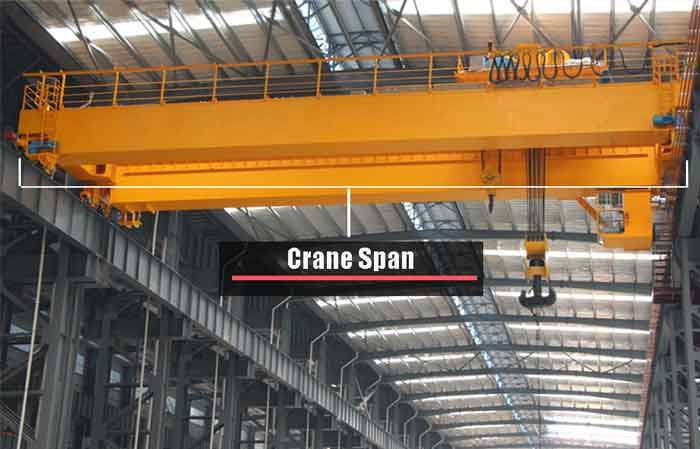
Span length:
Span length refers to the distance between the runways of an overhead crane, typically measured horizontally. It defines the coverage area in which the crane can operate and determines the maximum distance over which it can transport loads. Span length plays a crucial role in overhead crane design and directly affects its performance, capabilities, and price.
Customizing the span length of an overhead crane involves tailoring the distance between the runways to suit specific operational requirements and spatial constraints. Here's how to customize the span length for your needs:
- Evaluate Workspace Dimensions: Assess the dimensions of the workspace where the overhead crane will be installed, including the length and width of the building or facility. Consider any obstacles, obstructions, or structural limitations that may impact crane installation and operation.
- Determine Coverage Area: Determine the desired coverage area that the overhead crane needs to span to effectively reach and transport loads within the workspace. Consider factors such as the layout of workstations, storage areas, and material handling zones to optimize crane coverage and accessibility.
- Calculate Span Length: Based on the workspace dimensions and coverage requirements, calculate the optimal span length for the overhead crane. Ensure that the span length provides sufficient clearance for the crane to maneuver and transport loads safely and efficiently without encountering obstacles or obstructions.
- Consider Load Capacity: Take into account the anticipated load capacity and weight distribution of the loads to be lifted and transported by the overhead crane. Ensure that the selected span length can support the intended loads within the specified working envelope without exceeding design limits or compromising safety.
- Consult Crane Manufacturers: Consult with overhead crane manufacturers or suppliers to discuss custom span length options and obtain expert guidance on selecting the most suitable configuration for your needs. Manufacturers can provide customized crane solutions tailored to your specific workspace dimensions, operational requirements, and budget constraints.
The customization of span length directly influences overhead crane design and price:
- Design Impact: Customizing the span length requires adjustments to the crane's structural components, including runway beams, support structures, and end trucks. Engineering considerations such as load distribution, deflection limits, and structural stability are crucial in designing a crane with the desired span length.
- Price Considerations: The customization of span length may impact overhead crane price due to the additional materials, engineering, and manufacturing processes involved in accommodating specific design requirements. Longer span lengths may require heavier-duty structural components, increased reinforcement, and specialized fabrication, contributing to higher overall costs.
In summary, customizing the span length of an overhead crane involves evaluating workspace dimensions, determining coverage requirements, and consulting with crane manufacturers to design a solution that meets your needs. While customization may affect crane design and price, it ensures that the crane is optimized for efficient and safe operation within your unique work environment.
Hoist Speed and Control Systems:
Hoist speed and control systems are integral components of overhead cranes that govern the movement and operation of the hoist mechanism. These systems control the speed at which the hoist lifts and lowers loads, as well as the precision and coordination of movements along the crane's runway. Advanced hoist speed and control systems utilize sophisticated technology to enhance efficiency, productivity, and safety in material handling operations.
Selecting the right hoist speed and control systems for your needs involves considering several factors:
- Operational Requirements: Assess the specific lifting tasks and operational environment to determine the ideal hoist speed and control features. Factors such as load capacity, lift height, frequency of use, and precision requirements influence the selection process.
- Speed and Acceleration: Evaluate the required lifting and lowering speeds, as well as acceleration and deceleration rates, to match the crane's performance with operational demands. Faster hoist speeds may be necessary for high-volume operations, while precise control over acceleration and deceleration is crucial for handling delicate or sensitive loads.
- Control Options: Consider the available control options, such as pendant controls, radio remote controls, or automated control systems. Choose control interfaces that facilitate ease of operation, operator comfort, and intuitive functionality to enhance productivity and safety.
- Safety Features: Prioritize hoist speed and control systems equipped with advanced safety features, such as overload protection, anti-sway technology, and collision avoidance systems. These safety features mitigate risks and ensure compliance with industry regulations, reducing the likelihood of accidents and injuries.
- Integration with Crane Design: Ensure compatibility and seamless integration of hoist speed and control systems with the overall crane design. Collaborate with crane manufacturers or suppliers to customize the system layout, interface, and components to meet specific requirements and optimize crane performance.
The selection of hoist speed and control systems directly influences overhead crane design and price:
- Design Impact: Hoist speed and control systems affect various aspects of crane design, including structural reinforcement, electrical wiring, and control panel configuration. Advanced systems may require additional engineering considerations to accommodate specialized components and ensure compatibility with existing infrastructure.
- Price Considerations: The integration of advanced hoist speed and control systems typically incurs higher manufacturing and installation costs due to the complexity of technology and specialized components involved. Customization options, safety features, and control interfaces contribute to the overall price of the crane, reflecting the investment required to achieve enhanced performance and functionality.
In summary, selecting the right hoist speed and control systems involves evaluating operational requirements, safety considerations, and integration with crane design. While advanced systems may entail higher upfront costs, their long-term benefits in terms of productivity, safety, and operational efficiency justify the investment for businesses seeking to optimize their material handling operations.
Customization Options:
Customization options for 5 ton overhead cranes refer to the various features, configurations, and accessories that can be tailored to meet specific operational requirements and application needs. These options allow businesses to optimize crane performance, enhance productivity, and improve safety in their material handling processes. Here's how to customize a 5 ton overhead crane for your needs:
- Identify Operational Requirements: Begin by identifying your facility's unique operational requirements and the specific challenges you aim to address with the overhead crane. Consider factors such as load types, lifting heights, duty cycles, and environmental conditions to determine the customization options that best suit your needs.
- Select Lifting Mechanism: Choose the appropriate lifting mechanism based on the types of loads to be handled and the desired efficiency and precision of lifting operations. Options include wire rope hoists, chain hoists, and electric chain hoists, each offering different capabilities and performance characteristics.
- Tailor Control System: Customize the control system of the overhead crane to suit your operational preferences and safety requirements. Options range from basic pendant controls to advanced radio remote controls and automated systems with programmable features for precise load positioning and motion control.
- Optimize Safety Features: Enhance safety by incorporating additional safety features and devices into the crane design. These may include overload protection systems, emergency stop buttons, collision avoidance sensors, and warning alarms to mitigate risks and prevent accidents in the workplace.
- Add Specialized Attachments: Consider adding specialized lifting attachments or accessories to the crane to facilitate specific material handling tasks. These may include lifting magnets, vacuum lifters, spreader bars, or custom-designed lifting beams tailored to the shape and size of your loads.
- Integrate Automation: Explore automation options to streamline crane operations and improve efficiency. Automation features such as automatic load positioning, anti-sway control, and remote monitoring capabilities can optimize workflow and reduce manual intervention, leading to increased productivity.
- Customize Aesthetics: Customize the appearance of the overhead crane to align with your facility's branding or aesthetic preferences. Options for customization may include color choices, corporate logos, and protective coatings to enhance the crane's visual appeal and integration into the workplace environment.
Customizing the design of a 5 ton overhead crane to incorporate these options can affect the crane's price in several ways:
- Material and Component Costs: Additional features and accessories may require the use of specialized materials, components, and manufacturing processes, leading to increased material costs.
- Engineering and Design Complexity: Customization often involves engineering modifications and design adjustments to integrate the desired features into the crane's structure and mechanisms, resulting in higher engineering and design costs.
- Installation and Commissioning: The installation and commissioning of a customized overhead crane may require additional time, labor, and expertise to ensure proper integration and functionality, contributing to higher installation costs.
In summary, customizing a 5 ton overhead crane involves selecting tailored features, control systems, safety devices, attachments, automation options, and aesthetic enhancements to meet specific operational requirements. While customization can enhance crane performance and functionality, it may impact the crane's price due to increased material, engineering, installation, and commissioning costs associated with the custom design.
Safety features and compliance:
Safety features play a critical role in ensuring the safe operation of overhead cranes and protecting personnel, equipment, and materials in industrial environments. Here are some common safety features and their impact on overhead crane price:
- Overload Protection Systems: These systems monitor the load being lifted and automatically stop the crane or issue warnings if the load exceeds safe limits. Overload protection systems help prevent accidents caused by overloading and minimize the risk of equipment damage.
- Emergency Stop Buttons: Emergency stop buttons allow operators to quickly stop crane motion in case of emergencies or safety hazards. These buttons are strategically located on the crane pendant or control panel for easy access in urgent situations.
- Limit Switches: Limit switches prevent the crane from traveling beyond specified limits, such as the end of the runway or the upper/lower hook positions. Limit switches help prevent collisions, entanglements, and other accidents resulting from crane overtravel.
- Collision Avoidance Systems: These systems use sensors and advanced algorithms to detect obstacles in the crane's path and automatically adjust its motion to avoid collisions. Collision avoidance systems enhance safety in busy work environments with multiple cranes and overlapping work areas.
- Warning Alarms and Lights: Audible alarms and visual indicators alert personnel to the presence of the crane and its movements, reducing the risk of accidents due to crane blind spots or unexpected motions. Warning alarms and lights improve situational awareness and promote safer working practices.
- Anti-Sway Control: Anti-sway control systems minimize load sway during lifting and positioning operations, enhancing precision and stability. By reducing load oscillations, anti-sway control systems improve safety and efficiency, particularly when handling fragile or delicate materials.
- Automatic Brake Systems: These systems engage brakes automatically when the crane is stationary or during power loss, preventing unintended movements and ensuring the crane remains securely positioned. Automatic brake systems enhance safety during loading, unloading, and idle periods.
- Operator Training and Certification Programs: While not strictly safety features of the crane itself, comprehensive operator training and certification programs are essential for ensuring safe crane operation. Investing in operator training helps minimize the risk of accidents, injuries, and equipment damage due to operator error.
Incorporating advanced safety features and ensuring regulatory compliance may result in additional costs during the design, manufacturing, installation, and commissioning stages of overhead crane procurement. Factors contributing to the increased price include:
- Specialized Components: Advanced safety features often require the integration of specialized components, sensors, controllers, and software, which may be more expensive than standard counterparts.
- Engineering and Design Modifications: Designing and engineering cranes with advanced safety features may require additional time and expertise to ensure proper integration and functionality, leading to higher engineering and design costs.
- Certification and Compliance Testing: Ensuring compliance with safety standards and regulatory requirements may involve certification testing, inspections, and documentation, which can incur additional expenses.
- Despite the upfront costs, investing in advanced safety features adds long-term value to overhead cranes by reducing the risk of accidents, injuries, and downtime. By prioritizing safety, businesses can create safer work environments, improve productivity, and protect their most valuable assets— their employees and equipment.
Brand reputation and quality:
The reputation and quality standards of the crane manufacturer play a significant role in determining the price of the overhead crane. Reputable brands with a track record of reliability and performance often command higher prices for their products. While opting for a reputable brand may entail a higher initial investment, it offers the assurance of superior quality, durability, and after-sales support, thereby providing long-term value.
Brand reputation refers to the perception and recognition of a company's name, products, and services within the industry and among customers. A brand with a strong reputation is often associated with qualities such as reliability, performance, innovation, and customer satisfaction. Here's how brand reputation and quality affect overhead crane prices:
- Reliability and Performance: Established brands with a reputation for reliability and performance often command higher prices for their overhead cranes. Customers are willing to pay a premium for cranes from reputable brands because they trust the quality and durability of the products. These brands have a track record of delivering reliable solutions that meet or exceed customer expectations, reducing the risk of downtime and costly repairs.
- Innovation and Technology: Leading brands invest heavily in research and development to innovate new technologies and enhance crane performance. Cranes from reputable brands often feature advanced technologies, such as smart automation, digital controls, and predictive maintenance systems, which improve efficiency, safety, and productivity. The integration of these innovative features contributes to higher overhead crane prices but delivers long-term value through improved performance and operational efficiency.
- Customer Support and Service: Reputable brands prioritize customer satisfaction and provide comprehensive support services throughout the crane's lifecycle. This includes assistance with crane selection, installation, training, maintenance, and troubleshooting. Customers are willing to pay a premium for cranes from brands that offer reliable customer support, as they have confidence that their needs will be met promptly and effectively.
- Quality Standards and Certification: Established brands adhere to strict quality standards and certifications to ensure that their products meet industry regulations and customer requirements. Cranes from reputable brands undergo rigorous testing and inspection processes to validate their performance, reliability, and safety. The commitment to quality assurance adds value to the crane and justifies the higher price tag associated with reputable brands.
- Brand Equity and Trust: Brand reputation influences customer perceptions and purchasing decisions. Customers are more likely to trust and invest in cranes from brands with a positive reputation and a proven track record of delivering high-quality products and services. The intangible value of brand equity contributes to higher overhead crane prices for reputable brands, as customers are willing to pay for the assurance of quality and reliability.
Overall, brand reputation and quality are significant determinants of overhead crane prices. Customers view cranes from reputable brands as a worthwhile investment due to their reliability, performance, innovation, customer support, and brand equity. While cranes from reputable brands may come with a higher upfront cost, they offer long-term value, reliability, and peace of mind to customers, making them a preferred choice in the market.
Brand reputation and quality influence overhead crane prices in several ways:
- Higher Initial Cost: Cranes from reputable brands often come with a higher upfront cost compared to lesser-known brands. The premium price reflects the brand's reputation for quality, reliability, and performance.
- Value Proposition: Customers perceive cranes from reputable brands as offering better value for money due to their superior quality, durability, and after-sales support. As a result, they are willing to pay a premium for these cranes, considering them as long-term investments.
- Quality Components: Reputable brands use high-quality materials and components in their cranes, which contribute to their durability and longevity. While these components may incur higher manufacturing costs, they enhance the overall performance and reliability of the crane.
- Advanced Technologies: Leading brands invest in research and development to innovate new technologies and features for their cranes. These advanced technologies, such as smart automation and digital controls, improve efficiency, safety, and productivity but may also contribute to higher crane prices.
- Customer Support: Reputable brands offer comprehensive customer support services, including assistance with crane selection, installation, training, maintenance, and troubleshooting. The added value of reliable customer support justifies the higher price tag associated with these brands.
- Certifications and Compliance: Cranes from reputable brands undergo rigorous testing and certification processes to ensure compliance with industry standards and regulations. The cost of obtaining these certifications and maintaining compliance is reflected in the crane's price.
Overall, brand reputation and quality play a crucial role in determining the perceived value and pricing of overhead cranes. Customers are willing to pay a premium for cranes from reputable brands due to their trust in the brand's reliability, performance, and after-sales support. While these cranes may have a higher initial cost, they offer long-term benefits in terms of durability, efficiency, and peace of mind.
Pricing Ranges and Variations
Exploring budget-friendly options versus premium models:
It's essential to weigh the features and quality offered by budget-friendly and premium models when investing in a 5 ton overhead crane. While budget-friendly options may offer basic functionality at a lower price point, premium models often boast advanced features, enhanced durability, and superior performance. By comparing these options, businesses can determine the best fit for their operational needs and budget constraints.
Typical price range: 12,000 – 20,000:
Providing readers with a realistic price range based on market trends and standard configurations offers valuable insights into the investment required for a 5 ton overhead crane. The price range may vary depending on factors such as lifting capacity, span length, customization options, and brand reputation. By understanding the typical price range, businesses can set realistic budget expectations and make informed decisions when procuring an overhead crane.
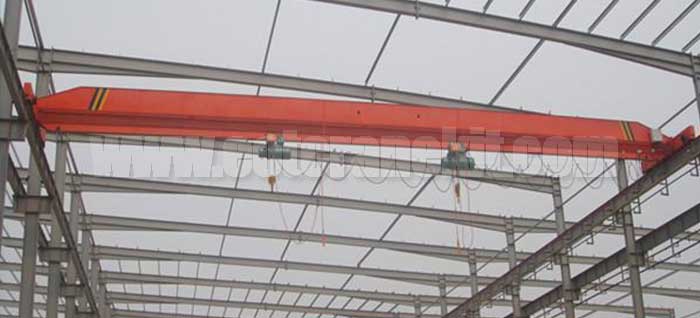
Single Girder Overhead Crane 5 Ton For Sale
Single girder overhead cranes are ideal for small to medium-sized operations with a load capacity ranging from 1 to 20 tons. Single girder cranes are cost-effective and easy to install, making them an excellent choice for businesses with limited budgets or space constraints.
General Single Girder Overhead CranesPricerRange for Your Reference
| Lifting Capacity (Tons) | Span (m) | Lifting Height (m) | Price Range (USD) |
| 1 ton | 10 | 6 | 6,000 – 10,000 |
| 2 ton | 12 | 6 | 8,000 – 12,000 |
| 3 ton | 14 | 6 | 10,000 – 15,000 |
| 5 ton | 16 | 6 | 12,000 – 20,000 |
| 10 ton | 20 | 6 | 20,000 – 30,000 |
| 15 ton | 22 | 6 | 25,000 – 40,000 |
| 20 ton | 24 | 6 | 35,000 – 50,000 |
Single girder bridge cranes prices are for reference purposes only and may vary depending on various factors such as lifting capacity, span, lifting height, power supply, actual working environment, and customer's special requirements. Customized quote for the single girder overhead crane that meets your project's needs.
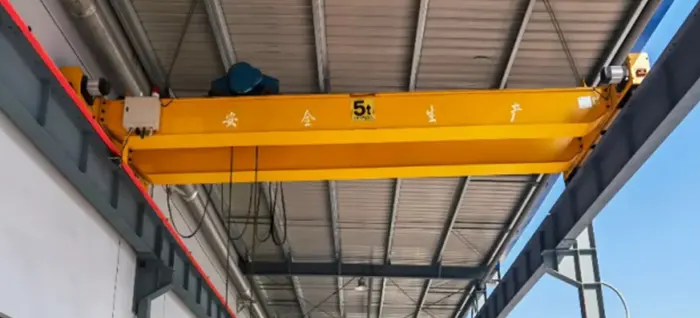
Double Girder Overhead Crane 5 Ton For Sale
With a load capacity of up to 500 tons, double girder bridge cranes are designed to handle heavy-duty lifting tasks. These cranes offer increased stability, better hook height, and greater load capacity compared to single girder cranes. They are well-suited for large-scale operations and demanding industries.
Double Girder Overhead Cranes Price Range for Your Reference.
| Lifting Capacity (Tons) | Span (m) | Lifting Height (m) | Price Range (USD) |
| 5 ton | 16 | 6 | 15,000 – 25,000 |
| 10 ton | 20 | 6 | 25,000 – 40,000 |
| 15 ton | 22 | 6 | 30,000 – 50,000 |
| 20 ton | 24 | 6 | 40,000 – 60,000 |
| 30 ton | 26 | 6 | 50,000 – 80,000 |
| 50 ton | 28 | 6 | 70,000 – 120,000 |
| 75 ton | 30 | 6 | 90,000 – 150,000 |
| 100 ton | 32 | 6 | 120,000 – 200,000 |
The price ranges given in the table are for general reference only and do not account for any specific customizations or additional features that might be required for your project. The actual price may vary based on the factors mentioned earlier.
European Style Overhead Cranes For Sale
European style overhead cranes feature advanced technology, offering improved performance, energy efficiency, and low maintenance requirements. European style overhead cranes are designed to be lightweight, yet still provide excellent load capacity and precision.
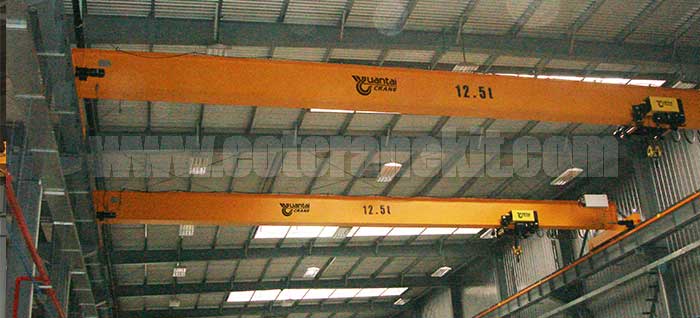
Singel girder overhead crane 5 ton
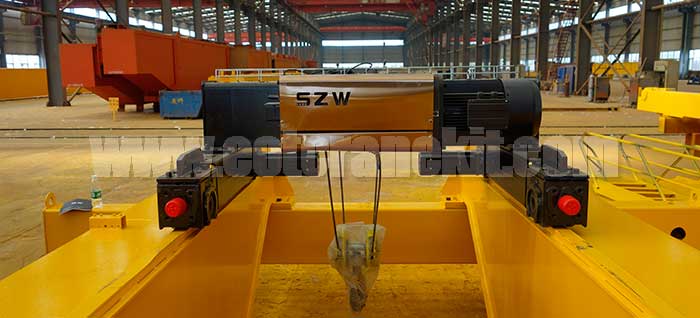
Double girder overhead crane 5 ton
European Style Overhead Cranes Price Range for Your Reference
| Lifting Capacity (Tons) | Span (m) | Lifting Height (m) | European Style (USD) |
| 1 ton | 10 | 6 | 8,000 – 12,000 |
| 5 ton | 16 | 6 | 20,000 – 30,000 |
| 10 ton | 20 | 6 | 30,000 – 45,000 |
| 15 ton | 22 | 6 | 40,000 – 60,000 |
| 20 ton | 24 | 6 | 50,000 – 70,000 |
| 30 ton | 26 | 6 | 60,000 – 90,000 |
| 50 ton | 28 | 6 | 80,000 – 130,000 |
| 75 ton | 30 | 6 | 100,000 – 170,000 |
| 100 ton | 32 | 6 | 130,000 – 220,000 |
To obtain an accurate quote for a european style overhead crane tailored to your specific needs, please contact the crane manufacturer directly.
Tailored quotes to meet your unique needs
Every business has unique operational requirements and budget constraints, necessitating customized solutions for optimal efficiency and cost-effectiveness. By partnering with experienced crane suppliers, businesses can unlock custom solutions tailored to their specific needs. These tailored quotes take into account factors such as lifting capacity, span length, customization options, and budget limitations, ensuring that businesses receive a crane solution that maximizes cost savings and efficiency gains. Emphasizing the potential benefits of custom solutions, such as increased productivity, reduced downtime, and enhanced safety, encourages readers to explore this option further.
By exploring the pricing ranges, variations, and custom solutions available for 5 ton overhead cranes, businesses can make strategic decisions that align with their operational goals and budgetary constraints. In the next section, we'll delve into the crucial role of crane design and specifications in determining pricing and performance. Stay tuned for valuable insights into optimizing your crane investment.
Tailored quotes to meet your unique needs
Every business has unique operational requirements and budget constraints, necessitating customized solutions for optimal efficiency and cost-effectiveness. By partnering with experienced crane suppliers, businesses can unlock custom solutions tailored to their specific needs. These tailored quotes take into account factors such as lifting capacity, span length, customization options, and budget limitations, ensuring that businesses receive a crane solution that maximizes cost savings and efficiency gains. Emphasizing the potential benefits of custom solutions, such as increased productivity, reduced downtime, and enhanced safety, encourages readers to explore this option further.
By exploring the pricing ranges, variations, and custom solutions available for 5 ton overhead cranes, businesses can make strategic decisions that align with their operational goals and budgetary constraints. In the next section, we'll delve into the crucial role of crane design and specifications in determining pricing and performance. Stay tuned for insights into optimizing your crane investment.
Buying Considerations
Selecting the right 5 ton overhead crane involves more than just comparing features and prices. It requires careful consideration of various factors to ensure that the investment aligns with operational needs and budget constraints. Let's explore the key buying considerations:
Needs assessment and project planning's role in pricing
Before investing in a 5 ton overhead crane, it's essential to conduct a comprehensive needs assessment and project planning. This involves evaluating operational requirements, such as lifting capacity, span length, and frequency of use, to determine the optimal crane configuration. Additionally, project planning helps identify budget constraints and any specific challenges that may impact crane installation or operation. By aligning crane investments with operational needs and budget constraints from the outset, businesses can avoid costly mistakes and ensure that the chosen crane solution delivers maximum value.
The needs assessment and project planning stage play a pivotal role in determining the pricing and overall success of a 5 ton overhead crane investment. Here's why:
- Operational Requirements: Conducting a thorough needs assessment involves analyzing various operational factors, including lifting capacity, span length, and usage frequency. By understanding these requirements, businesses can determine the specific capabilities and features required from the overhead crane to meet their operational needs effectively.
- Determining Optimal Crane Configuration: Based on the results of the needs assessment, businesses can determine the optimal configuration for the overhead crane. This includes selecting the appropriate lifting capacity, span length, and other specifications to ensure that the crane can perform the required tasks efficiently and safely.
- Identifying Budget Constraints: Project planning also involves identifying budgetary constraints and financial considerations associated with the overhead crane investment. By establishing a clear budget upfront, businesses can make informed decisions about which crane features and customization options are feasible within their financial limitations.
- Addressing Specific Challenges: Project planning allows businesses to anticipate and address any specific challenges that may arise during crane installation or operation. This could include factors such as space limitations, structural requirements, or regulatory compliance issues. By proactively addressing these challenges, businesses can avoid costly delays or setbacks during the implementation process.
- Maximizing Value and ROI: By aligning crane investments with operational needs and budget constraints, businesses can ensure that they are maximizing the value and return on investment (ROI) of the overhead crane. Investing in a crane solution that meets specific operational requirements while staying within budgetary constraints ensures that businesses are getting the most value for their investment.
In summary, conducting a comprehensive needs assessment and project planning process is essential for determining the optimal configuration, addressing budget constraints, and maximizing the value of a 5 ton overhead crane investment. By taking these factors into account from the outset, businesses can make informed decisions that lead to successful crane implementations and long-term operational benefits.
Supplier evaluation and selection's impact on pricing
Choosing the right supplier is crucial in obtaining a competitive price and ensuring quality assurance for a 5 ton overhead crane. Businesses should research reputable manufacturers and suppliers, considering factors such as industry experience, product quality, and customer reviews. Additionally, negotiating terms with potential suppliers can help secure favorable pricing and contractual agreements. By carefully evaluating and selecting a reliable supplier, businesses can obtain a high-quality crane solution at a competitive price, minimizing the risk of project delays or cost overruns.
The process of evaluating and selecting a supplier significantly influences the pricing and overall success of procuring a 5 ton overhead crane. Here's how:
- Researching Reputable Manufacturers and Suppliers: Conducting thorough research on potential manufacturers and suppliers is the first step in the supplier evaluation process. This involves gathering information about their industry experience, reputation, and track record of delivering quality products. By choosing suppliers with a proven history of excellence, businesses can mitigate the risk of receiving substandard crane equipment that may result in operational inefficiencies or safety hazards.
- Considering Product Quality and Customer Reviews: Assessing the quality of products and services offered by potential suppliers is essential for making informed decisions. Businesses should review customer feedback, testimonials, and case studies to gauge the supplier's reputation and customer satisfaction levels. Positive reviews and endorsements from satisfied customers indicate that the supplier can be relied upon to deliver high-quality crane solutions that meet or exceed expectations.
- Negotiating Terms and Pricing: Negotiating favorable terms and pricing with potential suppliers is key to securing a competitive deal for the overhead crane investment. Businesses should leverage their research findings and industry knowledge to negotiate pricing, payment terms, and contractual agreements that align with their budgetary constraints and operational requirements. By engaging in transparent and collaborative negotiations, businesses can achieve mutually beneficial outcomes that optimize value and minimize costs.
- Ensuring Quality Assurance and Timely Delivery: Quality assurance and timely delivery are critical factors in supplier selection. Businesses should verify that potential suppliers adhere to stringent quality control standards and have robust processes in place to ensure product reliability and safety. Additionally, confirming the supplier's ability to meet project deadlines and delivery schedules is essential for avoiding costly delays and disruptions to operations.
- Minimizing Project Risks and Cost Overruns: Selecting a reliable supplier reduces the risk of project delays, cost overruns, and unforeseen complications associated with crane procurement. By partnering with a reputable supplier, businesses can minimize project risks and uncertainties, ensuring a smooth and successful implementation process from start to finish.
In summary, supplier evaluation and selection play a crucial role in obtaining a competitive price and ensuring quality assurance for a 5 ton overhead crane investment. By conducting thorough research, negotiating favorable terms, and choosing a reputable supplier, businesses can optimize value and minimize risks associated with crane procurement.
Value assessment and its influence on pricing
While price is an important consideration, it's equally essential to evaluate the overall value proposition of a 5 ton overhead crane investment. Conducting a cost-benefit analysis helps businesses assess the long-term return on investment and determine whether the benefits of the crane solution justify the upfront costs. Factors such as increased productivity, reduced downtime, and improved safety should be weighed against the initial investment to determine the true value of the crane solution. By considering the broader implications and benefits of the investment, businesses can make informed decisions that maximize value and drive operational success.
Assessing the value proposition of a 5 ton overhead crane investment goes beyond just considering the upfront price tag. Here's how it influences pricing decisions:
- Conducting a Cost-Benefit Analysis: Before committing to a crane investment, businesses should conduct a comprehensive cost-benefit analysis to evaluate the overall value proposition. This involves comparing the upfront costs of acquiring and installing the crane against the potential long-term benefits it offers. By quantifying the expected returns in terms of increased productivity, reduced downtime, and improved safety, businesses can determine whether the investment is financially viable and aligns with their strategic objectives.
- Weighing Long-Term Benefits: While price is a crucial factor, it's essential to consider the long-term benefits that a 5 ton overhead crane can deliver. Investing in a high-quality crane solution may require a larger upfront investment, but it can result in significant cost savings and efficiency gains over its operational lifespan. Businesses should evaluate factors such as durability, reliability, and maintenance requirements to assess the true value of the crane solution beyond its initial purchase price.
- Maximizing Operational Efficiency: A well-chosen overhead crane can enhance operational efficiency and streamline material handling processes, resulting in increased productivity and profitability. Businesses should consider how the crane solution integrates with existing workflows and operational processes to maximize its impact on efficiency and throughput. By prioritizing solutions that align with operational needs and goals, businesses can optimize value and drive sustainable growth.
- Mitigating Risk and Uncertainty: Investing in a high-quality overhead crane solution can help businesses mitigate operational risks and uncertainties associated with equipment failure, accidents, and downtime. By prioritizing safety features, regulatory compliance, and reliability, businesses can minimize the risk of costly disruptions and ensure uninterrupted operations. Additionally, choosing a reputable supplier with a proven track record of delivering quality products and excellent customer service can provide peace of mind and minimize the risk of project delays or budget overruns.
- Aligning with Strategic Objectives: Ultimately, the decision to invest in a 5 ton overhead crane should align with the organization's broader strategic objectives and goals. Businesses should consider how the crane solution contributes to their overall growth strategy, competitiveness, and long-term sustainability. By evaluating the impact of the investment on key performance indicators and strategic priorities, businesses can make informed decisions that drive value creation and operational success.
In summary, conducting a value assessment helps businesses evaluate the long-term benefits and implications of investing in a 5 ton overhead crane. By considering factors such as cost-effectiveness, operational efficiency, risk mitigation, and strategic alignment, businesses can make informed decisions that maximize value and drive sustainable growth.
Installation and Assembly
The installation and assembly of a 5 ton overhead crane are critical stages that can significantly impact both the upfront costs and long-term performance of the crane. Let's delve into the various aspects of installation and assembly:
Site preparation requirements and their pricing implications
Before installing a 5 ton overhead crane, adequate site preparation is essential to ensure a safe and efficient operation. This includes structural considerations such as reinforcing floors or installing support beams, as well as electrical provisions for powering the crane and its components. The complexity of site preparation requirements can vary depending on factors such as the existing infrastructure and site conditions, and it can have a direct impact on installation costs and the overall price of the crane.
Preparing the site for the installation of a 5 ton overhead crane involves several crucial considerations that can impact both the installation costs and the overall price of the crane. Here's how site preparation requirements influence pricing:
- Structural Considerations: One of the primary aspects of site preparation is ensuring that the structural integrity of the building can support the weight and operation of the overhead crane. This may involve reinforcing floors with additional concrete or steel supports to handle the crane's load-bearing requirements. Structural modifications can significantly impact installation costs, especially if extensive reinforcements are necessary to meet safety standards and building codes.
- Electrical Provisions: Overhead cranes require electrical power to operate their motors, controls, and other components effectively. As part of site preparation, electrical provisions must be made to ensure that the crane has access to sufficient power sources. This may involve installing new electrical wiring, outlets, or transformers to accommodate the crane's power requirements. The complexity of electrical work can vary depending on the distance from existing power sources and the capacity of the electrical infrastructure, affecting installation costs accordingly.
- Environmental Considerations: Site preparation may also involve addressing environmental factors such as ventilation, lighting, and climate control to create a safe and comfortable working environment for crane operators and personnel. This could include installing ventilation systems, lighting fixtures, or climate control units to optimize conditions within the facility. Environmental upgrades can add to the overall price of the crane installation, especially if specialized equipment or modifications are required to meet specific regulatory requirements or industry standards.
- Site Accessibility and Logistics: The accessibility of the site and logistical challenges can also impact installation costs and timelines. Factors such as limited access for equipment and personnel, restricted maneuvering space, or the need for special permits or approvals can add complexity to the installation process. Site-specific challenges may require additional planning, resources, or coordination with external stakeholders, potentially increasing the overall price of the crane installation.
- Safety and Compliance Requirements: Ensuring compliance with safety regulations and industry standards is paramount during site preparation to mitigate risks and prevent accidents. This may involve conducting site surveys, risk assessments, and safety audits to identify potential hazards and implement appropriate safety measures. Compliance with safety requirements may incur additional costs for safety equipment, signage, or training programs, but it is essential for maintaining a safe work environment and minimizing liabilities.
In summary, site preparation requirements play a critical role in determining the overall price of installing a 5 ton overhead crane. By addressing structural, electrical, environmental, logistical, and safety considerations during the site preparation process, businesses can ensure a smooth and cost-effective installation that meets their operational needs and regulatory requirements.
Professional installation vs. DIY assembly's effect on pricing
When it comes to installing a 5 ton overhead crane, businesses must weigh the costs and benefits of hiring professional installers versus opting for DIY assembly. While DIY assembly may seem cost-effective initially, it can lead to safety risks, operational inefficiencies, and potential damage to the crane or surrounding infrastructure if not done correctly. On the other hand, professional installation by certified installers ensures compliance with safety standards, proper assembly, and optimal performance of the crane. While professional installation may incur higher upfront costs, it provides peace of mind and long-term reliability, ultimately delivering better value for the investment.
The choice between professional installation and DIY assembly can significantly impact the overall price and performance of a 5 ton overhead crane. Here's how each option affects pricing:
DIY Assembly:
DIY assembly involves installing the overhead crane without the assistance of professional installers. While this approach may seem cost-effective initially, it comes with several potential drawbacks.
Cost Savings: DIY assembly may appear cheaper upfront since businesses can avoid paying for professional installation services. However, it's essential to consider the long-term costs and risks associated with this approach.
Safety Risks: Without proper training and expertise, DIY assembly can pose significant safety risks to personnel and equipment. Improper installation techniques or mistakes during assembly can lead to accidents, injuries, and damage to the crane or surrounding infrastructure.
Operational Inefficiencies: DIY assembly may result in suboptimal performance or functionality if the crane is not installed correctly. Misaligned components, inadequate calibration, or incomplete assembly can affect the crane's reliability and efficiency during operation.
Potential Damage: Incorrectly installed cranes can cause damage to the building structure, equipment, or other assets. Repairing or replacing damaged components can incur additional costs and downtime, negating any initial savings from DIY assembly.
Professional Installation:
Professional installation involves hiring certified installers or crane specialists to assemble and install the overhead crane. While this approach may require higher upfront costs, it offers several advantages in terms of safety, performance, and reliability.
Compliance with Standards: Professional installers ensure that the overhead crane is installed according to industry standards and regulatory requirements. This includes proper alignment, calibration, and testing to meet safety and performance criteria.
Optimal Performance: Certified installers have the expertise and experience to ensure that the crane operates efficiently and reliably. Proper installation techniques and calibration procedures maximize the crane's performance and lifespan, minimizing the risk of operational issues or breakdowns.
Warranty Coverage: Many crane manufacturers offer warranty coverage for professionally installed cranes, providing added protection and peace of mind for businesses. Warranty terms may include coverage for parts, labor, and repairs, reducing the financial risks associated with unexpected maintenance or repairs.
Long-Term Value: While professional installation may entail higher upfront costs, it delivers better long-term value by ensuring the safety, reliability, and performance of the overhead crane. Businesses can avoid costly repairs, downtime, and liabilities associated with DIY assembly, ultimately saving money and preserving the integrity of their investment.
In summary, while DIY assembly may seem like a cost-effective option, it can lead to safety risks, operational inefficiencies, and potential damage to equipment. Professional installation by certified installers offers superior safety, performance, and reliability, delivering better long-term value for businesses. By investing in professional installation services, businesses can ensure that their overhead crane operates optimally and meets the highest standards of safety and quality.
Testing and commissioning's impact on pricing
After installation, thorough testing and commissioning are essential to ensure that the 5 ton overhead crane operates safely and effectively. This includes functional testing of components and systems, safety inspections, and certification processes to verify compliance with regulatory standards. While testing and commissioning may add to the installation costs, they are crucial steps in ensuring operational readiness and minimizing the risk of accidents or downtime. Investing in proper testing and commissioning procedures upfront can help avoid costly repairs or adjustments later on, ultimately contributing to the overall value and performance of the crane.
Testing and commissioning play a critical role in ensuring the safe and effective operation of a 5 ton overhead crane. Here's how these processes impact pricing:
Functional Testing:
Functional testing involves evaluating the performance and functionality of various components and systems of the overhead crane. This includes testing the hoist, trolley, bridge, and control systems to ensure proper operation and coordination.
Cost Implications: Conducting comprehensive functional testing requires time, resources, and specialized equipment. While this adds to the upfront costs of installation, it is essential for identifying any issues or deficiencies that need to be addressed before the crane is put into service.
Safety Inspections:
Safety inspections are conducted to verify that the overhead crane meets safety standards and regulatory requirements. This includes inspecting structural components, electrical systems, and safety features to ensure compliance with applicable standards.
Cost Implications: Safety inspections may require the involvement of certified inspectors or third-party organizations, which can incur additional fees. However, ensuring compliance with safety standards is essential for protecting personnel, equipment, and facilities, ultimately justifying the investment in inspection services.
Certification Processes:
Certification processes involve obtaining official documentation or certifications to verify that the overhead crane meets regulatory requirements and industry standards. This may include obtaining certifications from regulatory agencies or industry organizations.
Cost Implications: Certification processes may involve administrative fees, documentation costs, and compliance assessments, depending on the regulatory requirements and certification bodies involved. While these costs add to the overall price of the crane, they provide assurance that the crane meets the necessary safety and performance standards.
Operational Readiness:
Testing and commissioning ensure that the overhead crane is operationally ready and capable of performing its intended functions safely and effectively. By identifying and addressing any issues during the testing phase, businesses can minimize the risk of accidents, downtime, or performance issues after the crane is put into service.
Cost Savings: Investing in thorough testing and commissioning procedures upfront can help businesses avoid costly repairs, adjustments, or downtime later on. By ensuring that the crane is properly calibrated, aligned, and tested before operation, businesses can maximize the value and longevity of their investment.
In summary, while testing and commissioning may add to the upfront costs of installing a 5 ton overhead crane, they are essential steps in ensuring operational readiness, safety, and compliance. By investing in thorough testing and commissioning procedures, businesses can minimize the risk of accidents, downtime, and performance issues, ultimately maximizing the value and performance of their overhead crane investment.
Operation and Maintenance
Efficient operation and proactive maintenance are key to maximizing the performance and lifespan of a 5 ton overhead crane. Let's explore the crucial aspects of operation and maintenance:
Operator training and certification's role in pricing
The proper training and certification of crane operators are paramount for ensuring safe and efficient crane operation. While investing in operator training may incur upfront costs, it significantly reduces the risk of accidents, injuries, and downtime caused by operator error. Trained and certified operators are better equipped to handle the complexities of crane operation, resulting in smoother workflow and enhanced productivity. By prioritizing operator training and certification, businesses can mitigate risks and safeguard their investments in crane equipment.
Operator training and certification play a crucial role in ensuring the safe and efficient operation of overhead cranes. Here's how they impact pricing:
Training Costs:
Operator training programs typically incur upfront costs, which may include course fees, materials, and instructor expenses. These costs depend on the duration and complexity of the training program, as well as the credentials of the training provider.
Cost Implications: While investing in operator training involves initial expenses, it provides long-term benefits by equipping operators with the knowledge and skills needed to operate overhead cranes safely and effectively. The cost of training is justified by the reduction in accidents, injuries, and downtime resulting from operator error.
Certification Fees:
Obtaining certification for crane operators may involve fees for examinations, assessments, and certification documentation. These fees vary depending on the certifying body and the level of certification sought by the operator.
Cost Implications: Certification fees add to the overall investment in operator training but provide tangible evidence of an operator's competency and compliance with regulatory standards. Certified operators are better positioned to operate cranes safely and confidently, reducing the risk of accidents and liabilities for businesses.
Productivity Gains:
Well-trained and certified operators are more proficient in crane operation, leading to increased productivity and efficiency in material handling operations. They can perform tasks more quickly, accurately, and safely, resulting in smoother workflow and reduced downtime.
Cost Savings: The productivity gains achieved through operator training and certification can translate into significant cost savings over time. By maximizing the efficiency of crane operations, businesses can minimize labor costs, optimize resource utilization, and enhance overall operational performance.
Risk Mitigation:
Investing in operator training and certification helps businesses mitigate risks associated with crane operation, such as accidents, injuries, and equipment damage. Trained operators are better equipped to identify and respond to potential hazards, reducing the likelihood of incidents that could result in costly liabilities or regulatory penalties.
Cost Avoidance: While the initial investment in operator training may seem significant, it pales in comparison to the potential costs associated with accidents, injuries, or legal disputes resulting from inadequate training or operator error. By proactively investing in training, businesses can avoid costly consequences and protect their bottom line.
In summary, while operator training and certification involve upfront costs, they provide significant long-term benefits in terms of safety, productivity, and risk management. By prioritizing operator training and certification, businesses can ensure the safe and efficient operation of their overhead cranes, ultimately maximizing the return on their investment in crane equipment.
Preventive maintenance practices and their pricing effects
Preventive maintenance is essential for prolonging the lifespan of a 5 ton overhead crane and minimizing maintenance costs over time. Scheduled inspections, lubrication of moving parts, and timely replacement of worn-out components help prevent unexpected breakdowns and ensure optimal crane performance. While implementing preventive maintenance practices may require upfront investment in maintenance personnel, tools, and materials, the long-term benefits far outweigh the costs. By proactively addressing maintenance needs, businesses can avoid costly repairs and downtime, thereby maximizing the return on their crane investment.
Preventive maintenance practices are critical for ensuring the longevity and reliable performance of 5 ton overhead cranes. Here's how these practices impact pricing:
Maintenance Personnel Costs:
Implementing preventive maintenance requires skilled personnel to conduct inspections, perform lubrication, and replace worn-out components. Hiring or training maintenance technicians incurs labor costs, including salaries, benefits, and training expenses.
Cost Implications: While employing maintenance personnel adds to operational expenses, their expertise is essential for maintaining crane functionality and preventing costly breakdowns. Investing in skilled maintenance staff ensures timely and effective maintenance, reducing the risk of unexpected downtime and associated losses.
Tools and Equipment Costs:
Preventive maintenance activities often require specialized tools, equipment, and consumables such as lubricants, greases, and replacement parts. Procuring these items incurs upfront costs, including purchase or rental expenses.
Cost Implications: While investing in maintenance tools and equipment involves initial capital outlay, it enables maintenance personnel to perform tasks efficiently and effectively. Having the right tools on hand facilitates timely maintenance interventions, minimizing crane downtime and optimizing operational productivity.
Materials Costs:
Preventive maintenance practices, such as lubrication and component replacement, require materials such as lubricants, greases, bearings, seals, and electrical components. These materials incur costs, which may vary depending on the quality and quantity required.
Cost Implications: While purchasing maintenance materials adds to operating expenses, using high-quality materials ensures optimal crane performance and longevity. Investing in premium-grade materials reduces the risk of premature wear and tear, minimizing the frequency of maintenance interventions and associated costs over time.
Downtime Costs Avoidance:
Implementing preventive maintenance helps businesses avoid costly downtime resulting from unexpected crane failures or breakdowns. By proactively addressing maintenance needs, businesses minimize the risk of unplanned interruptions to production or material handling operations.
Cost Savings: While preventive maintenance involves upfront investment, the cost savings associated with avoiding downtime far outweigh the expenses incurred. By maximizing crane uptime and operational efficiency, businesses can maintain productivity levels and meet production targets, ultimately enhancing profitability and competitiveness.
Long-Term Value:
By prioritizing preventive maintenance practices, businesses protect their investment in overhead cranes and extend their operational lifespan. Regular maintenance helps preserve crane functionality, reliability, and safety, ensuring continued performance and value over the long term.
Cost-Benefit Analysis: While preventive maintenance incurs ongoing costs, conducting a cost-benefit analysis reveals its positive impact on overall operational efficiency and cost savings. By comparing the expenses associated with maintenance against the potential costs of crane downtime and repairs, businesses can justify the investment in preventive maintenance and realize its long-term benefits.
Emergency troubleshooting and support's impact on pricing
Despite diligent maintenance efforts, unforeseen issues may arise that require immediate attention to maintain crane reliability and operational continuity. Access to technical support, on-site assistance, and spare parts management services is crucial for addressing emergency situations promptly and effectively. While these support services may entail additional costs, they provide peace of mind and minimize disruptions to workflow. Investing in comprehensive emergency troubleshooting and support ensures that businesses can quickly resolve issues and resume operations, ultimately optimizing crane performance and minimizing downtime-related losses.
Emergency troubleshooting and support services play a vital role in ensuring the uninterrupted operation of 5 ton overhead cranes. Here's how these services impact pricing:
Service Contract Costs:
Many crane suppliers offer service contracts that include emergency troubleshooting and support services. These contracts typically involve a recurring fee or subscription-based pricing structure, covering access to technical support, on-site assistance, and spare parts management.
Cost Implications: While subscribing to a service contract incurs regular expenses, it provides businesses with proactive support and rapid response to emergencies. By budgeting for service contract fees, businesses can mitigate the financial impact of unexpected crane issues and ensure timely resolution of problems.
On-Demand Service Costs:
In cases where businesses opt for on-demand emergency support services, they may incur variable costs based on the extent of assistance required and the response time. Service providers may charge hourly rates or fixed fees for emergency callouts, diagnostic assessments, and onsite repairs.
Cost Implications: While on-demand services offer flexibility, they may result in higher costs during emergencies, especially if response times are critical. Businesses should weigh the cost of on-demand support against the potential losses associated with prolonged crane downtime to determine the most cost-effective option.
Spare Parts Inventory Costs:
Maintaining an inventory of critical spare parts and components is essential for expedited repairs and minimizing downtime during emergencies. Procuring spare parts incurs upfront costs, including purchase prices, stocking fees, and inventory management expenses.
Cost Implications: While investing in spare parts inventory adds to inventory carrying costs, it ensures rapid access to replacement components when needed. By strategically managing spare parts inventory levels, businesses can balance the cost of stockpiling against the benefits of reduced downtime and operational disruptions.
Operational Continuity Benefits:
Timely resolution of crane emergencies through troubleshooting and support services helps businesses maintain operational continuity and minimize production interruptions. By quickly addressing issues and restoring crane functionality, businesses can avoid costly delays in material handling operations.
Cost Savings: While emergency support services involve additional expenses, the cost savings associated with maintaining operational continuity far outweigh the costs incurred. By preventing prolonged downtime and its associated losses, businesses safeguard their revenue streams and preserve customer satisfaction.
Risk Mitigation and Insurance Considerations:
Investing in emergency troubleshooting and support services serves as a risk mitigation strategy, reducing the likelihood and impact of crane-related disruptions. Businesses may also consider insurance coverage options to mitigate financial risks associated with crane downtime and repairs.
Cost-Benefit Analysis: When evaluating the cost of emergency support services, businesses should conduct a cost-benefit analysis to assess the potential financial impact of crane downtime versus the investment in proactive support measures. By quantifying the potential losses and comparing them to the costs of support services, businesses can make informed decisions to optimize operational resilience and minimize financial risks.
Conclusion
As we reach the end of our comprehensive guide to 5 ton overhead cranes, let's recap the key considerations and insights discussed:
Recap of key considerations in 5 ton overhead crane pricing and related topics:
Throughout this guide, we've explored the various factors influencing the pricing of 5 ton overhead cranes, including lifting capacity, span length, customization options, and maintenance practices. We've emphasized the importance of understanding these factors to make informed decisions and optimize crane investments.
Tailored Solutions Await: Reach out for a custom quote designed for your needs:
Every business has unique operational requirements and budget constraints. We've highlighted the opportunity to explore custom solutions tailored to specific needs, ensuring that businesses receive crane solutions that maximize efficiency and value.
Now that you're equipped with valuable insights into overhead crane pricing and related topics, it's time to take action. Reach out to us today for expert guidance and assistance in acquiring your ideal 5 ton overhead crane solution. Our team is ready to help you navigate the procurement process and find the perfect crane solution to meet your operational needs and budget requirements.
Related Products

Latest project
150 Ton Overhead Crane Installation Feedback – Paraguay Case
QDX 150 ton overhead crane in action in Paraguay. Installation photos, video, and client feedback show performance, safety, and heavy-lifting efficiency.
Free consultation to Confirm Parameters & Specifications and Get
Latest Crane Price & Crane Rate.
- Types of overhead cranes : _______?
- Optional: Overhead travelling crane, goliath gantry crane,Slewing jib crane, Single girder or double girder crane,small portable crane or kbk crane, etc.
- Capacity of overhead crane: _______?
- Optional: 0.25ton, 0.5 ton, 1 ton, 2 ton, 3ton, 5 ton, 10 ton,15ton, 20ton, 25 ton, 30ton,35ton, up to 550ton, etc.
- Crane span & lifting height : _______?
- Crane travelling length : _____?
- Control of overhead crane:_______?
- Optional: pendant/ remote/cabin control
- Voltage supply of overhead crane:_____?
- Eg,: 380V50/60HZ,3Phase or others,etc.
- Application/usage of crane:_______?
- Eg,: Steel mill, ,injection mold, cement,stone, concrete,granite, general manufacturing, etc.
Just leave a message via the contact form and our hoist and crane engineer will contact you with in 24working hours.
Get In Touch

